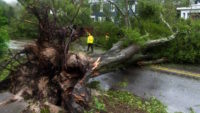There’s no big wall planned to protect North Carolina’s coast from storm surge. There’s no massive tunnel system proposed to keep floodwaters away from populated areas. There are no grant-funded resilience competitions to help the state plan to manage water more effectively.
There are, though, dozens of smaller efforts to tackle the big problem of climate change and more extreme weather events. Informed by flooding from Hurricane Floyd in 1999, Hurricane Matthew in 2016 and multiple events in between, communities from North Carolina’s coast to its mountains are doing what they can to prevent flooding and protect people.
It’s not just North Carolina. Communities around the nation are trying to prepare for changes in weather patterns.
“I have a lot of people ask, ‘What is our Harvey?’ and can they plan for it,” says Nathan Foged, managing engineer of flood resilience for Brown and Caldwell.
After Hurricane Matthew, North Carolina and the Federal Emergency Management Agency embarked on a $100-million-plus buyout program to move people out of harm’s way and reclaim some of the land for water retention. Those buyouts had just begun when Hurricane Florence hit.
While some North Carolina residents, and politicians, may not want to talk openly about climate change, “There’s a difference between what people understand and what people say,” says Jamie Kruse, an economics professor at East Carolina University and director of the Center for Natural Hazards Research. “They may know there is a problem, but they may not say that they know. What they would really like to do is to sell it before it comes to harm and loses value,” she says.
Cities and counties are also doing what they can to address the problem. After Hurricane Matthew, the Fayetteville City Council increased its stormwater fee to pay for studies of the city’s 15 watersheds within the next five years. Before the storm, the city had planned to complete one study every two years. The information would set the priorities to improve drainage, better manage heavy floodwaters and eliminate repetitive losses, says Giselle Rodriguez, city engineer. What the city won’t do, she says, is build a system that will completely alleviate flooding from storms like Florence and Matthew. “That’s just not cost effective,” she says.
At the Cape Fear Public Utility Authority, encounters with previous storms have led the PUA to build or rebuild systems in areas that are on higher ground, says Jim Fletchtner, executive director. The agency also has honed its emergency management plans, and knows where to preposition and when to start generators at pump stations. “We also get the right people in the right places,” he says. The PUA did have a hiccup during Florence—it didn’t have enough diesel fuel to run the generators. At the last minute, local contractors came to the rescue with diesel fuel from job sites. “We will learn from this storm,” Fletchtner says.
Aside from these individual efforts, Gavin Smith, director of U.S. Dept. of Homeland Security Coastal Resilience Center of Excellence at the University of North Carolina, says it may be time for the state to look at a broader approach, including reevaluating the flood risk standard. “Maybe we should inject climate change into recovery efforts,” he says. Resilience and adaptation experts agree. “What we’ve seen with Harvey, Irma, Florence—we need to shift gears and plan for the extreme,” says Edgar Westerhoff, national director for flood risk and resiliency for Arcadis. The task is huge. “It’s a multigenerational challenge to resolve the once-in-100-year flooding,” he says.
Flexibility and adaptation are key, says Rosey Jencks, vice president of stormwater management and planning for Brown and Caldwell. For instance, instead of trying to figure out what the future holds and plan to that uncertainty, Brown and Caldwell is helping communities to evaluate at what point will infrastructure fail and to build solutions that can be improved as time goes by, Foged says.
“Necessity is the mother of invention,” says Jencks. “There are way more people being impacted and way more people feeling responsible.”






Post a comment to this article
Report Abusive Comment